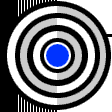| November 16, 2001 |
|
 |
 |
|
Part
2:
Sculpting the pulse, shaping the energy
Paul Preuss, paul_preuss@lbl.gov |
||
|
|
Much research demands intense pulses of neutrons, lasting a millionth
of a second or less, which shut off almost instantaneously. Pulses are
inherent in the basic design of many accelerators, but a "microchannel
extraction system," originally developed for ion lithography by AFRD's
Plasma and Ion Source Technology Group and Heavy Ion Fusion Group, brings
pulsed beams to compact generators as well. Microchannels can be opened
and closed electronically in an instant, generating extremely short pulses.
Accelerators that produce highly energetic neutrons need shielding several meters thick. Distance is also required to moderate neutrons to useful energies: experiments have to be placed a long way from the neutron source. But AFRD's compact sources produce lower-energy neutrons requiring only a few centimeters of shielding. Since Experiments can be placed nearby, the number of neutrons per unit area from the compact source actually equals or betters the powerful LANSCE accelerator, over the same range of useful energies. To build a small research laboratory equipped with one of Berkeley Lab's generators would cost about $5 million, Leung estimates. To get a comparable flux of neutrons would require a thousand commercial neutron tubes, costing $100 million. High-energy accelerators are another order of magnitude more expensive to build. Getting enough neutrons, at the right energy, just where they are needed, is a long-standing challenge — one the Berkeley Lab series of compact neutron generators has met efficiently and economically. Additional information:
|